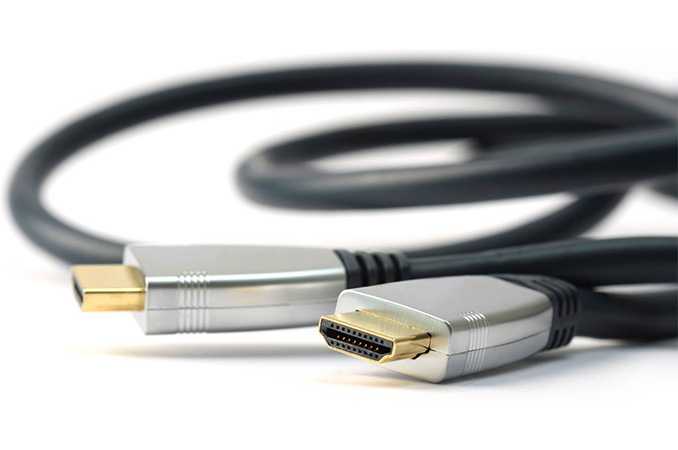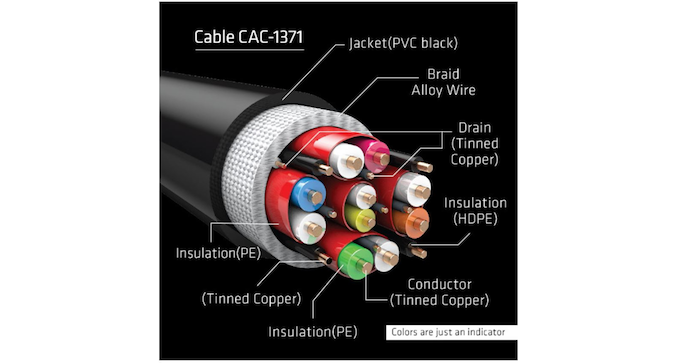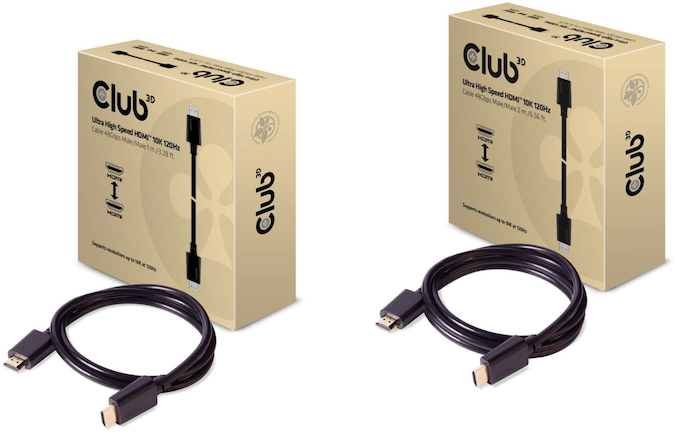HDMI 2.1 Nears Release: Club3D Announces Ultra-High Speed 48G Cable
by Anton Shilov on November 29, 2018 12:00 PM EST
As the first HDMI 2.1-enabled TVs are approaching release, we're finally seeing the market for HDMI 2.1 accessories fall into place to support those products. To that end, Club3D has announced the company’s first Ultra-High Speed HDMI 2.1 cables, which as per the UHS designation, are capable of supporting 48Gbps data rates. The new cables are aimed at next-generation UHDTVs featuring resolutions of up to 10240×4320 at 120 Hz with DSC 2.1 compression. Club3D’s new products fully support all of the features that the HDMI 2.1 spec calls for, so they should be future-proof and will handle everything that the consumer electronics industry will have to offer for years to come.
Club3D will offer two versions of its Ultra-High Speed 48G HDMI 2.1-supporting cables: the one-meter long CAC-1371 and the two-meter long CAC-1372. Both cables feature four data lanes operating at 12 Gbps each for an aggregate bandwidth of 48 Gbps, and as per the HDMI spec, retain backwards compatibility with existing equipment.
The ample bandwidth HDMI 2.1 provides enables it to support new UHD resolutions an refresh rates including, including 4Kp120, 8Kp100/120, 10Kp100/120, and upcoming color spaces, such as BT.2020 (Rec. 2020) with 10, 12, or even more advanced with 16 bits per color component. In fact, high resolutions and bit depths eat up 48 Gbps of bandwidth quickly, so for anything higher than 8Kp60 with 4:2:0 chroma sub sampling and 10-bit color, VESA’s DSC 1.2a link compression technology is used.
Besides new resolutions, refresh rates, and HDR bit depths, HDMI 2.1 support a number of new capabilities, including Variable Refresh Rate (VRR), Quick Media Switching (QMS), Quick Frame Transport (QFT), and eARC. The new features do not require UHS HDMI 2.1 cables for today’s content with up to 4Kp60 resolution with 4:4:4 chroma subsampling. Meanwhile, a combination of 4Kp120/4:4:4 and VRR will entail 48G cables.
Club3D has not announced pricing of its 48G HDMI 2.1 cables, but keeping in mind that the new cables are more complex to assemble than their predecessors, expect them to be more expensive than regular 18Gbps HDMI 1.4/2.0 cables.
Related Reading:
- HDMI 2.1 Specification Released: Variable Refresh, Dynamic HDR, & More In 2018
- HDMI 2.1 Announced: Supports 8Kp60, Dynamic HDR, New Color Spaces, New 48G Cable
- NVIDIA Announces Big Format Gaming Displays: 65-inch 4K@120Hz HDR Display with G-Sync & More
Source: Club3D (via TechPowerUp)












25 Comments
View All Comments
theuglyman0war - Sunday, December 2, 2018 - link
Still Nervous that the industry will produce fast 4k nvidia g-sync TN monitors with 1ms GtG but not support 3d Vision as well.Sure OLED would be fast enough to support as much also if they ever made a fast 27" to 32" 4k OLED 10 bit p3/rec 2020 HDR display that supported the die hard 3d gaming fan base community with 3D vision support on displays ( that support nvidia tech anyway ) that shader hacks it's own solutions nowadays...
I could finally sleep easy knowing my displays are future proofed for my favorite gaming technology ( stereoscopic aural and visual immersion for those of us with two ears and eyes ) before 3d vision dies.
With the stereoscopic investment going into VR/AR...
Find it easier to create assets respecting the experience of depth fidelity by using a lightweight solution like 3d glasses which can be slapped on quickly over leveraging a heavy cumbersome VR HMD to simply gauge an assets charm ( or lack of ) when viewed stereoscopically!
Which can expose blatantly obvious artifacts not apparent when viewed flat/2d. lowpoly cheapness and normal map depth fails particularly stand out revealed in their naked depth reality where their low fidelity cheapness can not hide in 2d.
Kind of sad that very few creatives I know personally do not work on stereoscopic projects like VR respecting the creation of their assets as viewed in their final depth revealed form/experience.
I liken it to an audio engineer or musician that monitors their stereo/surround audio soundtrack/music mix in mono reference only and expecting an honest result for their end users.
Sivar - Thursday, November 29, 2018 - link
It would be really nice to see an analysis of pre- and post- DSC 2.1 compression images."Perceptually lossless" claims given by vendors often apply to average-joe-off-the-street, the same people that can't tell the difference between DVD and Blu-ray.
It's hard to even find pre/post screen captures, which leads me to believe something is up.
DanNeely - Friday, November 30, 2018 - link
Is there any working hardware to make pre/post comparison images with?willis936 - Friday, November 30, 2018 - link
A displayport 1.4 capture card would work. They're not cheap though.Anato - Thursday, November 29, 2018 - link
Getting older has it's advantages, you simply don't care something like this as your eyes can't see the difference :-DPeachNCream - Friday, November 30, 2018 - link
That and you're too jaded to fall for placebo-effect marketing that companies use to farm money from the naive.MTEK - Friday, November 30, 2018 - link
Before you early adopters buy HDMI 2.1 equipment, you may want to ensure it supports HDCP 2.3 (yes, a new version is coming).atomt - Friday, November 30, 2018 - link
I have one of the earlier 4K sets with HDMI 2.0 - but it doesn't support HDCP 2.2 properly so a lot of content will downgrade to 1080p. Not falling into that trap again.rahvin - Friday, November 30, 2018 - link
How did you fall into that trap in the first place. When those first HDMI 2.0 sets went on sale there were warnings all over the internet not to buy them because they wouldn't support HDCP2.2.atomt - Friday, November 30, 2018 - link
I read some reviews and didnt see any such warnings at the time.